Sky-high photos bring architecture to life by revealing unique perspectives you can't see from the ground. They showcase the grandeur of buildings, their interaction with surroundings, and intricate geometric patterns in urban landscapes. Light and shadow play an essential role, adding depth and drama to structures. You'll notice how modern designs harmonize with their environments, from cityscapes to natural settings. Architectural details, like innovative rooftops and façades, become more apparent from above. The interplay of weather conditions and golden hour lighting can transform ordinary buildings into breathtaking works of art. There's a whole world of architectural beauty waiting to be discovered from up high.
Aerial Perspective and Scale

When you gaze upon sky-high architecture photos, you're immediately struck by their unique aerial perspective and extraordinary scale. These images offer a vantage point that's impossible to achieve from the ground, revealing the true grandeur of architectural marvels.
You'll notice how buildings interact with their surroundings, creating patterns and geometries that are often invisible at street level. The aerial perspective allows you to appreciate the intricate planning and design that goes into urban landscapes.
You'll see how skyscrapers punctuate the skyline, how green spaces weave through concrete jungles, and how transportation networks connect it all. This bird's-eye view also highlights the scale of human achievement, showcasing how we've transformed natural landscapes into sprawling metropolises.
In these photos, you'll observe how light and shadow play across building facades, creating depth and texture that's often missed from ground level. The scale becomes even more apparent when you compare the tallest structures to their smaller neighbors, emphasizing the sheer magnitude of our architectural accomplishments.
Through this elevated perspective, you gain a new appreciation for the complexity and beauty of our built environment.
Light and Shadow Interplay
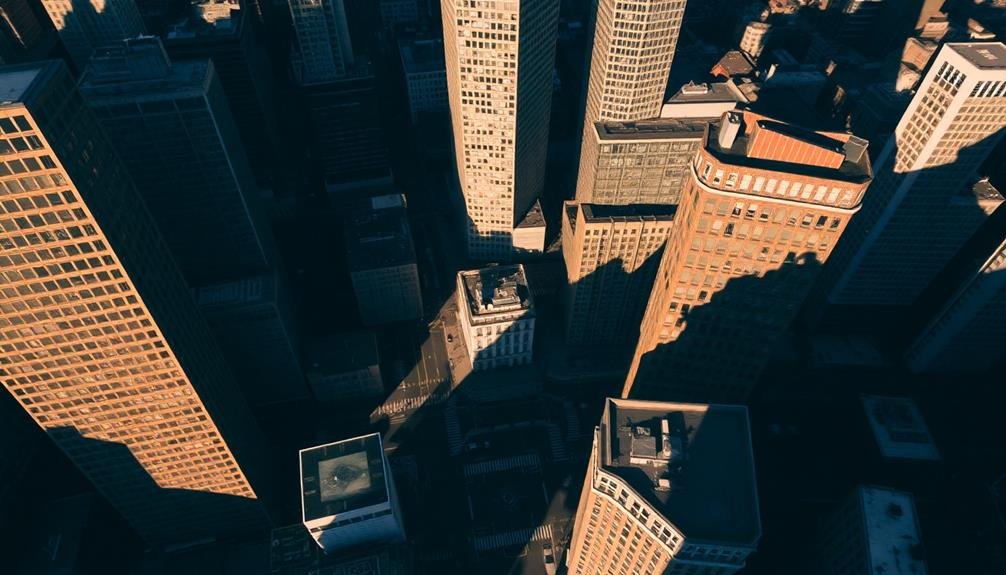
The interplay of light and shadow in sky-high architecture photos creates a mesmerizing visual symphony. You'll notice how sunlight dances across towering skyscrapers, casting long shadows that stretch across city landscapes. These contrasts add depth and dimension to your images, turning flat facades into intricate tapestries of light and dark.
As you shoot, pay attention to the time of day. Early morning and late afternoon offer golden hours when sunlight bathes buildings in warm hues, creating dramatic highlights and shadows. Midday sun can produce stark contrasts, emphasizing geometric patterns and architectural details.
Don't shy away from overcast days either; diffused light can reveal subtle textures and nuances in building materials. Experiment with backlighting to silhouette structures against bright skies, or capture sun flares peeking between buildings for added drama.
Look for reflections in glass facades, which can create fascinating plays of light and distorted cityscapes. Remember, shadows aren't just dark areas; they're an integral part of your composition, guiding the viewer's eye and adding mystery to your shots.
Geometric Patterns From Above
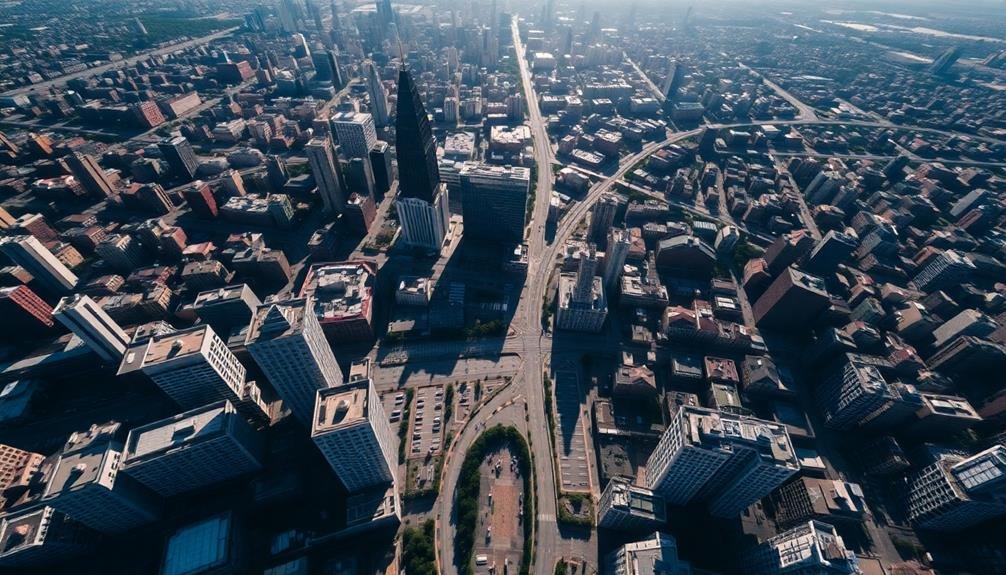
From high up above, geometric patterns in urban landscapes reveal themselves in stunning detail. You'll witness a mesmerizing tapestry of shapes and forms that aren't visible from street level. Aerial photography captures the intricate designs of city planning, architectural layouts, and infrastructure networks.
As you examine these sky-high shots, you'll notice how different urban elements create distinct geometric patterns:
| Element | Pattern Type |
|---|---|
| Streets | Grid or radial |
| Buildings | Rectangular or clustered |
| Parks | Organic or planned shapes |
| Waterways | Meandering or channeled |
These patterns offer insights into a city's history, development, and cultural influences. You'll see how older cities often feature winding streets and irregular layouts, while newer urban areas showcase strict grids and symmetrical designs.
Look for repeating shapes, such as the honeycomb-like arrangement of residential blocks or the concentric circles of roundabouts. Pay attention to how architects and urban planners use geometry to create functional and aesthetically pleasing spaces. You'll gain a new appreciation for the hidden beauty in everyday urban environments and the thoughtful design that goes into shaping our cities from the ground up.
Contextual Landscape Integration
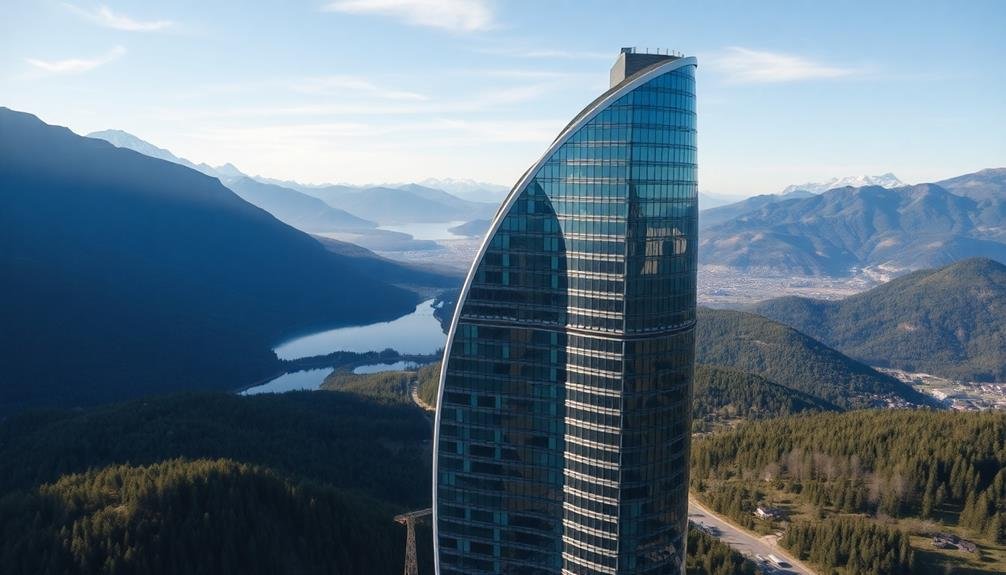
You'll notice how skilled architects seamlessly blend buildings into their surroundings through urban fabric harmonization and natural surroundings adaptation.
From above, you can see how structures meld with city grids or nestle into landscapes, creating a cohesive visual narrative.
Look closely, and you'll spot site-specific design elements that echo the local environment, further anchoring each building to its unique location.
Urban Fabric Harmonization
Nestled within the urban tapestry, sky-high architecture photos reveal how modern structures blend into their surroundings. You'll notice how these images capture the delicate balance between innovation and integration, showcasing buildings that complement rather than clash with their environment.
As you examine these aerial shots, you'll see how architects consider the existing cityscape when designing new structures. They're not just creating isolated monuments but contributing to a cohesive urban narrative. You'll observe how building materials, colors, and shapes are carefully chosen to harmonize with neighboring structures and local aesthetics.
| Element | Urban Integration | Visual Impact |
|---|---|---|
| Color | Matching facades | Seamless blend |
| Height | Gradual skyline | Respectful rise |
| Shape | Complementary forms | Unified look |
| Texture | Local materials | Contextual fit |
| Space | Thoughtful gaps | Breathing room |
These photos highlight the importance of urban planning and zoning regulations in maintaining a city's character. You'll appreciate how well-designed buildings can enhance the overall urban fabric, creating a sense of place and identity that respects the city's history while embracing its future.
Natural Surroundings Adaptation
Beyond the urban jungle, sky-high architecture photos reveal how modern structures adapt to their natural surroundings.
You'll notice how architects skillfully integrate buildings into diverse landscapes, from coastal cliffs to mountain ranges. These aerial shots showcase the symbiotic relationship between human-made structures and their environment.
Look for buildings that mirror the contours of nearby hills or complement the colors of surrounding forests. You'll spot green roofs that blend seamlessly with parklands, or reflective facades that capture the essence of nearby water bodies.
Notice how some structures seem to emerge organically from the terrain, while others create a striking contrast that enhances both the building and its setting.
Pay attention to how architects use local materials to harmonize with the landscape. You might see wooden facades in forested areas or stone exteriors in rocky regions.
Observe how buildings adapt to climate conditions, with sun-shading elements in hot climates or snow-shedding roofs in colder regions.
These photos highlight the ingenuity of designers who create structures that not only coexist with nature but often enhance it.
Site-Specific Design Elements
Site-specific design elements take center stage in aerial photographs of sky-high architecture. These unique features showcase how buildings interact with their surroundings, creating a visual narrative that's best appreciated from above.
You'll notice how architects incorporate local materials, colors, and textures to blend structures seamlessly into the landscape. From a bird's-eye view, you can spot rooftop gardens that mimic nearby natural terrain or solar panels arranged in patterns that complement the building's design.
Look for water features that reflect the sky or surrounding bodies of water, creating a visual connection between the structure and its environment. You might also see how building shapes are influenced by local topography, with curved edges echoing hillsides or angular forms mirroring nearby cliffs.
Pay attention to how outdoor spaces are integrated into the overall design. Terraces, balconies, and courtyards often follow the contours of the land, creating a harmonious flow between indoor and outdoor areas.
These site-specific elements not only enhance the building's functionality but also contribute to its visual appeal when captured in aerial photographs.
Architectural Details in Focus
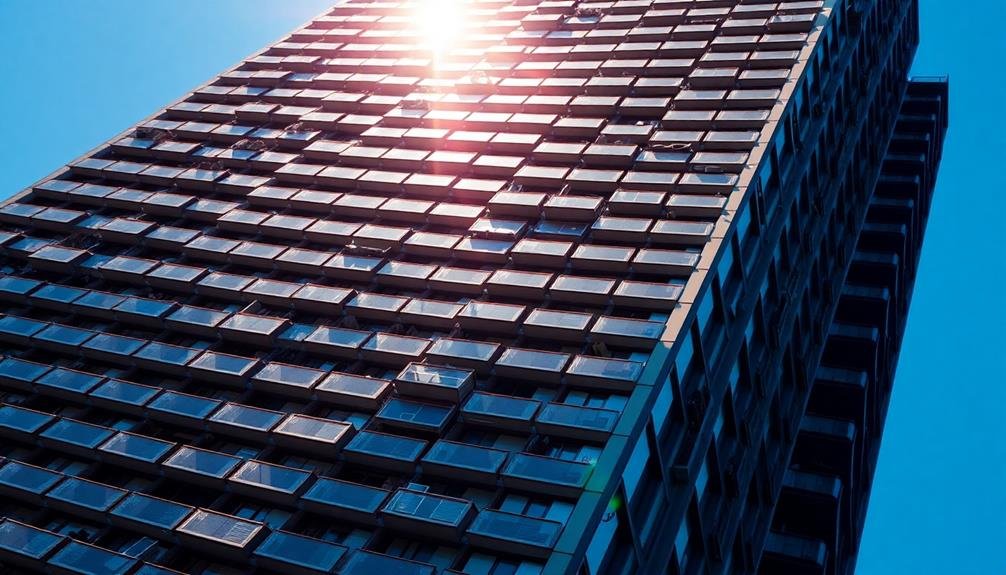
Five key architectural details come into sharp focus when viewed from above. First, you'll notice roof designs more clearly, from intricate patterns to innovative materials. These aerial views highlight the often-overlooked "fifth facade" of buildings.
Second, you'll spot geometric shapes and symmetry that mightn't be apparent from ground level. Buildings' overall forms and layouts become more evident, revealing the architect's grand vision.
Third, you'll see how buildings interact with their surroundings. Landscaping, courtyards, and integration with nearby structures become more apparent from this vantage point.
Fourth, you'll observe the play of light and shadow across surfaces, which can dramatically change a building's appearance throughout the day. This interplay often reveals texture and depth that ground-level views might miss.
Lastly, you'll notice the scale and proportion of architectural elements. From above, you can better appreciate how different components relate to each other and to the structure as a whole. This bird's-eye view offers a unique opportunity to understand the architect's intentions and the building's overall composition.
Dynamic Compositions and Angles
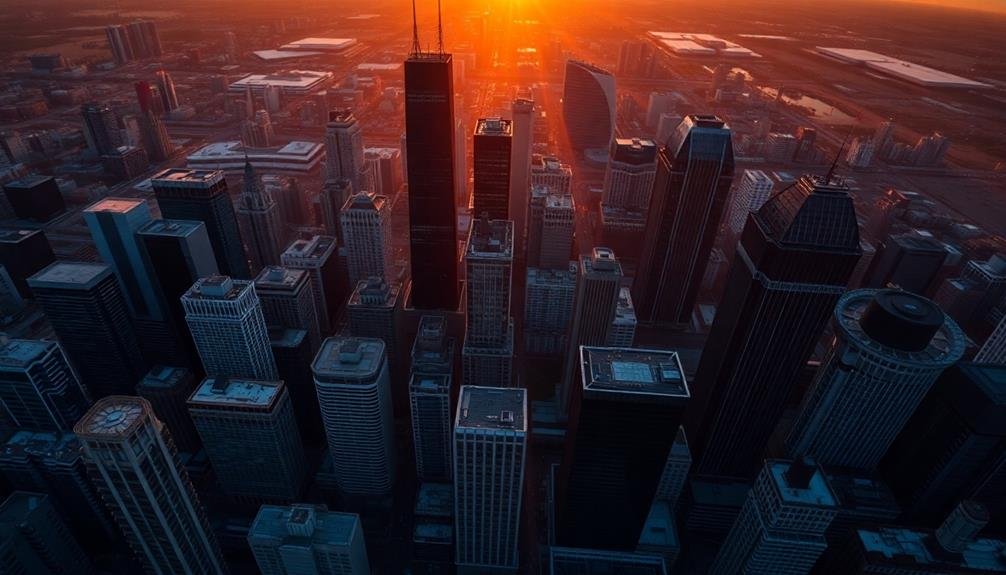
While architectural details shine from above, the true magic of sky-high photography lies in its dynamic compositions and angles. You'll find that capturing buildings from elevated perspectives allows you to play with unique visual arrangements that aren't possible from ground level.
Consider experimenting with diagonal lines and asymmetry to create tension and movement in your shots. You can use the edges of buildings, shadows, or even clouds to lead the viewer's eye through the frame.
Don't be afraid to tilt your camera for unconventional angles that emphasize a structure's height or create a sense of vertigo. Incorporate negative space to highlight the isolation of tall buildings against the sky.
You might also try juxtaposing different architectural styles or scales within a single composition. Look for patterns and repetitions in windows, balconies, or rooflines to add rhythm to your images.
Remember that timing is essential. The changing light throughout the day can dramatically alter the mood and impact of your compositions. Early morning or late afternoon light can cast long shadows, adding depth and dimension to your sky-high architectural shots.
Atmospheric Conditions and Mood

You'll find that atmospheric conditions can dramatically alter the mood of your sky-high architecture photos.
The golden hour, just after sunrise or before sunset, bathes buildings in warm, soft light that can transform even the most austere structures into ethereal marvels.
Dramatic weather elements like storm clouds, fog, or rain can add tension and mystery to your images, creating a powerful narrative around the architectural subject.
Golden Hour Magic
The golden hour casts a magical spell on skyscrapers, transforming them into shimmering beacons of light and color. This fleeting period, occurring just after sunrise or before sunset, bathes architecture in a warm, soft glow that can elevate your sky-high photos from ordinary to extraordinary.
During this time, you'll notice long shadows stretching across buildings, creating dramatic contrasts and emphasizing architectural details. The low-angled sunlight brings out textures and patterns that might go unnoticed in harsh midday light. Glass facades come alive, reflecting the golden hues of the sky and creating a dazzling display of color.
To capture this magic, you'll need to plan ahead. Research sunrise and sunset times for your location, and arrive early to set up your equipment.
Experiment with different angles and compositions to make the most of the golden light. Don't forget to adjust your camera settings to account for the changing light conditions. You might also consider using filters to enhance the warm tones and balance exposure.
With patience and practice, you'll be able to harness the golden hour's power to create stunning architectural images.
Dramatic Weather Elements
Amid the urban jungle, dramatic weather elements can transform ordinary skyscrapers into awe-inspiring subjects for photography. Storm clouds, lightning, fog, and rain can add depth, texture, and emotion to your architectural shots. These atmospheric conditions create a sense of drama and mystery, elevating your images from mundane to extraordinary.
When capturing stormy skies, look for contrast between dark clouds and illuminated buildings. Lightning strikes can provide electrifying focal points, while long exposures can turn rain into ethereal streaks. Fog can soften harsh lines and create a dreamlike atmosphere, making familiar structures appear otherworldly.
To capture these elements effectively, you'll need to be patient and prepared. Keep an eye on weather forecasts and be ready to head out at a moment's notice.
Use a sturdy tripod to stabilize your camera during long exposures, and consider using neutral density filters to balance bright skies with darker foregrounds. Don't forget to protect your gear from the elements with appropriate weather-sealing equipment.
Frequently Asked Questions
What Equipment Is Essential for Taking High-Quality Aerial Architectural Photos?
You'll need a high-resolution camera with a wide-angle lens for capturing expansive views. A drone with stabilization features is essential. Don't forget extra batteries, memory cards, and a remote controller for precise maneuvering during your aerial shoots.
How Do Photographers Ensure Safety When Capturing Sky-High Architectural Shots?
You'll need to prioritize safety when taking sky-high architectural shots. Always use proper harnesses and safety gear, obtain necessary permits, follow local regulations, and work with experienced professionals. Don't take risks; your life's more important than any photo.
Are There Legal Restrictions for Drone Photography of Buildings in Urban Areas?
You'll face legal restrictions when using drones for building photography in urban areas. You're often required to obtain permits, follow height limits, and avoid no-fly zones. Always check local regulations before launching your drone.
How Do Photographers Edit and Process Aerial Architectural Images for Optimal Results?
You'll want to focus on enhancing contrast, adjusting exposure, and fine-tuning colors to make buildings pop. Don't forget to straighten lines, remove distractions, and experiment with HDR techniques for ideal results in your aerial architectural shots.
What Are the Best Times of Day for Capturing Aerial Architecture Photos?
You'll get the best aerial architecture shots during golden hour, just after sunrise or before sunset. The soft, warm light enhances textures and creates dramatic shadows. Blue hour, right before sunrise or after sunset, offers magical twilight ambiance.
In Summary
You've seen how aerial photography breathes new life into architecture. From revealing grand scales to highlighting intricate details, sky-high shots offer a unique perspective. They'll transform your understanding of buildings and their surroundings. Next time you're looking at aerial images, you'll notice the interplay of light, geometry, and landscape. Remember, it's not just about the structure; it's about capturing the essence of design from above. Keep exploring these elevated views!

As educators and advocates for responsible drone use, we’re committed to sharing our knowledge and expertise with aspiring aerial photographers.




Leave a Reply